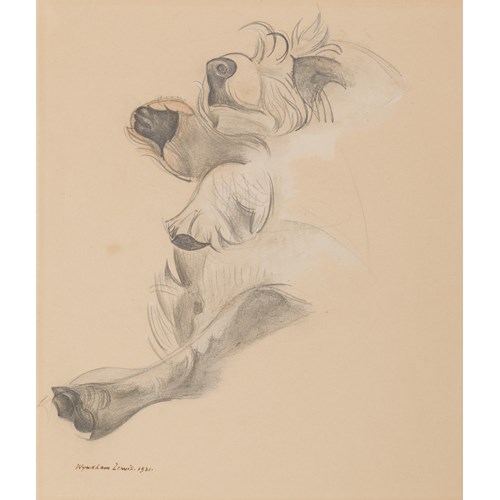Marketplace
Italian Columns (1965)
In 1950 Ben Nicholson made his first visit to Italy since the end of the Second World War, and over the next few years began to take a new interest in landscape. He produced a number of drawings of favourite views, sites and buildings throughout the provinces of Tuscany, Lazio and Umbria. As Peter Khoroche has noted of these drawings, ‘He might spend the morning wandering around a town, then be struck by some architectural feature or grouping and feel moved to draw it. Laying no claim to a technical or historical knowledge of architecture, what interested him was the shape, the proportion, the lie of a building – its inner essence or personality would speak off an idea for a free variation upon it. Buildings, like still life objects, were a starting point only: naturally there was no point in mere imitation. On the contrary, Nicholson realized that he had to dare to be free when creating one work of art out of another. Architecture in landscape offered an opportunity to combine his love of precise structure with his feeling for poetry and acute sensitivity to the spirit of place.’
As the artist’s inscription on the verso notes, this drawing was made in 1965. Nicholson’s Italian drawings reveal his fondness for local architecture and landscape; as the artist’s third wife Felicitas Vogler has written, ‘‘When I draw an Italian cathedral’, says Ben Nicholson, ‘I don’t draw its architecture, but the feeling it gives me.’...I have often observed on our travels how B.N. will sit rapt for an hour or two before his subject, usually motionless, but sometimes walking around it to view it from all angles...His landscapes and architectural drawings...are to my mind distinguished from a very early stage by clarity and the great art of omission. They have a delicacy combined with mastery in their strokes, which seem to become more and more economical with the passage of time. For all their fineness they are often of an almost palpable plasticity.’
In many of his Italian landscape drawings, Nicholson first applied a thin wash of oil paint to the surface of the paper, often well before he began the drawing itself. Peter Khoroche has noted that ‘One sign of the enhanced status of drawing within Nicholson’s work as a whole was his practice, from the late 1940s, of applying a thin wash of oil paint to part of each sheet of paper on which he intended to draw. This he did well in advance, without any idea as yet of the subjects he would choose to draw. Raw umber, raw sienna, turquoise or blue would be diluted with a varying proportion of turps, allowing the white ground of the paper to shine through. Like the prepared ground for a relief or a painting, the colour, shape and position of the oil wash provided a starting-point for work as well as giving the finished drawing more body and individuality. From a sheaf of these prepared sheets he would select whichever seemed appropriate to his idea of the landscape, architecture or still life he was about to draw.’
A gouache drawing of a related composition of the same year, but with a different arrangement of black and red colours, appeared on the art market in London in 2003. Also closely related are a small series of etchings entitled Urbino, produced between 1965 and 1966.
As the artist’s inscription on the verso notes, this drawing was made in 1965. Nicholson’s Italian drawings reveal his fondness for local architecture and landscape; as the artist’s third wife Felicitas Vogler has written, ‘‘When I draw an Italian cathedral’, says Ben Nicholson, ‘I don’t draw its architecture, but the feeling it gives me.’...I have often observed on our travels how B.N. will sit rapt for an hour or two before his subject, usually motionless, but sometimes walking around it to view it from all angles...His landscapes and architectural drawings...are to my mind distinguished from a very early stage by clarity and the great art of omission. They have a delicacy combined with mastery in their strokes, which seem to become more and more economical with the passage of time. For all their fineness they are often of an almost palpable plasticity.’
In many of his Italian landscape drawings, Nicholson first applied a thin wash of oil paint to the surface of the paper, often well before he began the drawing itself. Peter Khoroche has noted that ‘One sign of the enhanced status of drawing within Nicholson’s work as a whole was his practice, from the late 1940s, of applying a thin wash of oil paint to part of each sheet of paper on which he intended to draw. This he did well in advance, without any idea as yet of the subjects he would choose to draw. Raw umber, raw sienna, turquoise or blue would be diluted with a varying proportion of turps, allowing the white ground of the paper to shine through. Like the prepared ground for a relief or a painting, the colour, shape and position of the oil wash provided a starting-point for work as well as giving the finished drawing more body and individuality. From a sheaf of these prepared sheets he would select whichever seemed appropriate to his idea of the landscape, architecture or still life he was about to draw.’
A gouache drawing of a related composition of the same year, but with a different arrangement of black and red colours, appeared on the art market in London in 2003. Also closely related are a small series of etchings entitled Urbino, produced between 1965 and 1966.
Provenance: Galerie Beyeler, Basel
Private collection
Galerie Eric Coatalem, Paris
Private collection, France.
Plus d'œuvres d'art de la Galerie


_T638637429008849335.jpg?width=2000&height=2000&mode=max&scale=both&qlt=90)






